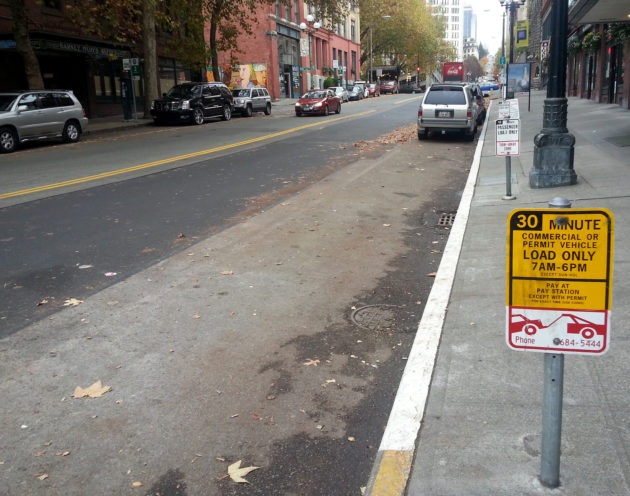 A loading zone in Seattle’s Pioneer Square neighborhood. (Flickr Photo / SDOT)
A loading zone in Seattle’s Pioneer Square neighborhood. (Flickr Photo / SDOT)
Over the past year, analysts from a Sidewalk Labs spinout called Coord have been playing a game of “would you rather?” with Seattle drivers. Would you rather shoot for rockstar parking downtown, knowing you may have to circle the block a few times, or have Google Maps direct you to a reasonably priced lot with known availability that’s within a few blocks of your destination?
 Coord CEO Stephen Smyth. (Coord Photo)
Coord CEO Stephen Smyth. (Coord Photo)
They found that many drivers would gladly trade the perfect spot for guaranteed off-street parking nearby. Encouraging drivers to do so cuts down on the congestion and carbon emissions caused by looking for parking in dense urban areas. The test led to a new feature developed by Coord and integrated into Google Maps. It allows drivers to search for available parking in Seattle and San Francisco.
That’s one of the more visible features of Coord, a new software platform for navigation apps, like Google Maps; transportation providers, like Uber and LimeBike; and public transit.
Coord is a spinout of Sidewalk Labs, the Google sister company under the Alphabet umbrella. Sidewalk develops technology for cities. Its most high-profile project is Sidewalk Toronto, a plan to build a high-tech district in partnership with the city.
Coord officially launched this week with behind-the-scenes technology designed to help all of the disparate transportation organizations speak the same language.
It’s the type of system that could support entire companies in the travel space. If a customer books a flight through Expedia, for example, computational gymnastics have to occur in the background to provide real-time information about pricing, seat availability, and other details across airlines. Coord wants to provide that same technology infrastructure for cities, by creating a consistent database of information on on tolls, curbs, parking, and modes of available transportation.
For example, Lyft could use Coord to locate legal pick-up zones and suggest drivers and passengers meet in one of those spots. ReachNow could bill users for tolls in real-time. Coord CEO Stephen Smyth compared it to municipal plumbing in an interview with GeekWire.
Related: This overlooked bit of urban infrastructure becomes a battleground for transportation innovators
“Instead of the industry and different participants building their own private plumbing networks, that are very expensive to build and maintain for that company, we think there’s real value in offering a service for all of the participants in the market so that we can have a high-quality plumbing network,” he said.
One core focus area for Coord is digitizing curb data. Curbs are becoming increasingly precious bits of urban infrastructure, as new transportation companies, delivery trucks, bicycles, and parked personal vehicles compete for space. But on-demand ride services don’t always have access to data on the rules governing curbs. Coord is trying to tackle that problem with a tool called Surveyor, which the company says can create a record of a single block’s curb regulations in four minutes using digital photos.
 A Coord employee uses Surveyor to collect street signs data. (Coord GIF)
A Coord employee uses Surveyor to collect street signs data. (Coord GIF)
“The upshot of all of this is cities do more with less ultimately,” Smyth said. He believes a tool like Coord is necessary as urban populations grow.
“Building a new subway line is a pretty expensive proposition,” he said. “The good news is there’s a lot of innovation occurring. A lot of mobility providers are offering creative new solutions to some of these mobility challenges but the byproduct of that is, of course, a bewildering set of options.”
Coord officially launched this week in cities across the country. Coord’s Curb API and Surveyor tool are starting in Seattle, San Francisco, New York City, and Los Angeles.
“Whether it’s a navigation app, whether it’s a mobility provider, we think that there are a lot of great consumer services out there,” Smyth said. “We think that what’s missing is really a connective tissue between them, which we feel is very necessary in order to deliver a seamless experience for the end user.”
